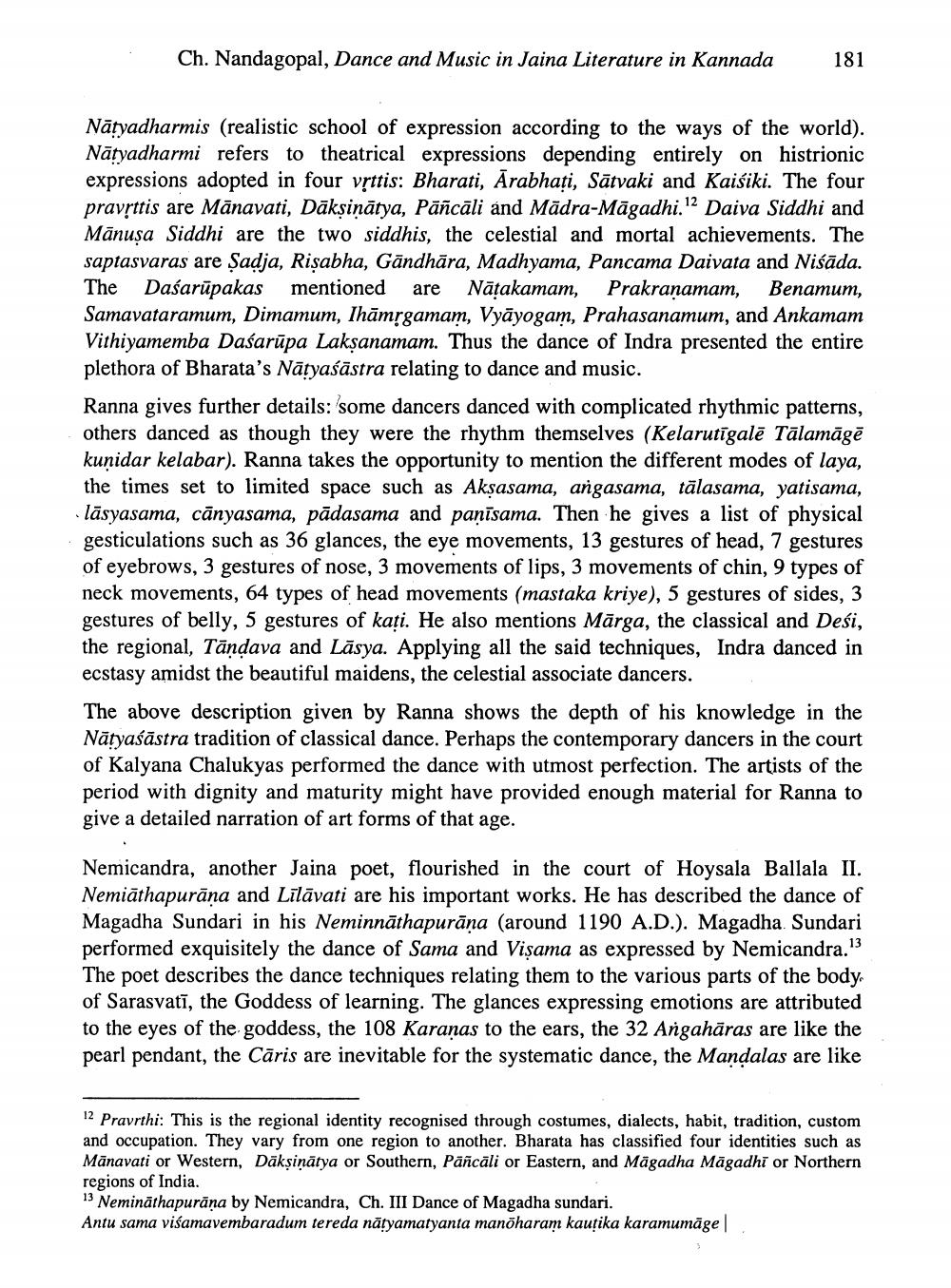________________
Ch. Nandagopal, Dance and Music in Jaina Literature in Kannada
181
Nātyadharmis (realistic school of expression according to the ways of the world). Nātyadharmi refers to theatrical expressions depending entirely on histrionic expressions adopted in four yrttis: Bharati, Arabhati, Sātvaki and Kaisiki. The four pravrttis are Mänavati, Dāksinātya, Pāñcāli and Mādra-Māgadhi. 12 Daiva Siddhi and Mānusa Siddhi are the two siddhis, the celestial and mortal achievements. The saptasvaras are Şadja, Risabha, Gāndhāra, Madhyama, Pancama Daivata and Niśāda. The Daśarūpakas mentioned are Nātakamam, Prakranamam, Benamum, Samavataramum, Dimamum, Ihāmsgamam, Vyāyogam, Prahasanamum, and Ankamam Vithiyamemba Dasarūpa Laksanamam. Thus the dance of Indra presented the entire plethora of Bharata's Nātyaśāstra relating to dance and music. Ranna gives further details: 'some dancers danced with complicated rhythmic patterns, others danced as though they were the rhythm themselves (Kelarutīgalē Tālamāgē kunidar kelabar). Ranna takes the opportunity to mention the different modes of laya, the times set to limited space such as Akşasama, angasama, tālasama, yatisama, lāsyasama, cānyasama, pādasama and panīsama. Then he gives a list of physical gesticulations such as 36 glances, the eye movements, 13 gestures of head, 7 gestures of eyebrows, 3 gestures of nose, 3 movements of lips, 3 movements of chin, 9 types of neck movements, 64 types of head movements (mastaka kriye), 5 gestures of sides, 3 gestures of belly, 5 gestures of kati. He also mentions Mārga, the classical and Desi, the regional, Tāndava and Lāsya. Applying all the said techniques, Indra danced in ecstasy amidst the beautiful maidens, the celestial associate dancers. The above description given by Ranna shows the depth of his knowledge in the Nātyaśāstra tradition of classical dance. Perhaps the contemporary dancers in the court of Kalyana Chalukyas performed the dance with utmost perfection. The artists of the period with dignity and maturity might have provided enough material for Ranna to give a detailed narration of art forms of that age.
Nemicandra, another Jaina poet, flourished in the court of Hoysala Ballala II. Nemiāthapurāna and Līlāvati are his important works. He has described the dance of Magadha Sundari in his Neminnāthapurāna (around 1190 A.D.). Magadha. Sundari performed exquisitely the dance of Sama and Vişama as expressed by Nemicandra." The poet describes the dance techniques relating them to the various parts of the body of Sarasvatī, the Goddess of learning. The glances expressing emotions are attributed to the eyes of the goddess, the 108 Karanas to the ears, the 32 Angahāras are like the pearl pendant, the Cāris are inevitable for the systematic dance, the Mandalas are like
12 Pravrthi: This is the regional identity recognised through costumes, dialects, habit, tradition, custom and occupation. They vary from one region to another. Bharata has classified four identities such as Mānavati or Western, Däksinātya or Southern, Pāñcāli or Eastern, and Magadha Māgadhi or Northern regions of India. 13 Nemināthapurāna by Nemicandra, Ch. III Dance of Magadha sundari. Antu sama visamavembaradum tereda nätyamatyanta manoharam kauţika karamumāge




